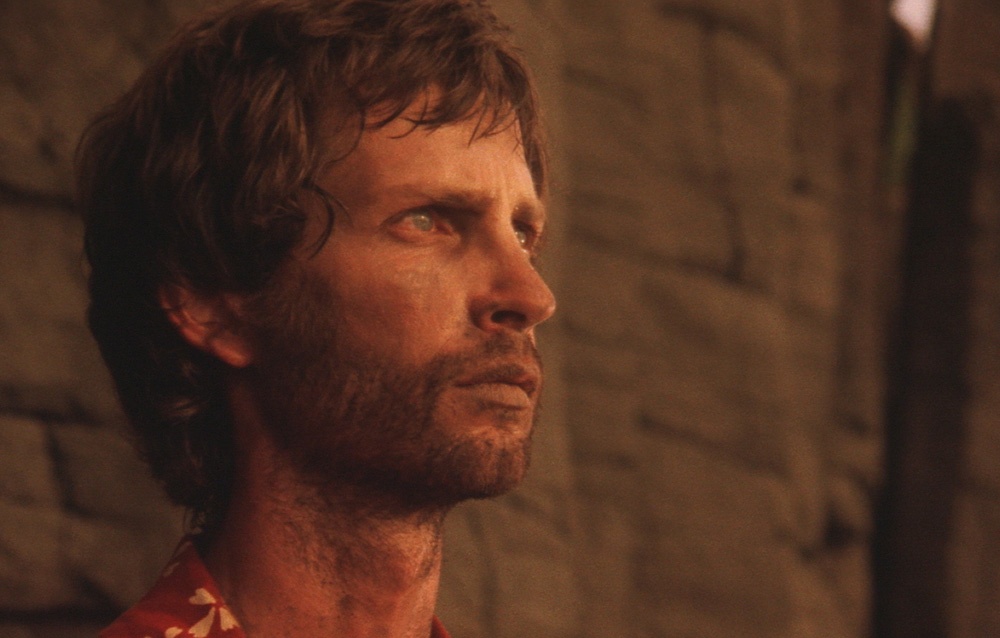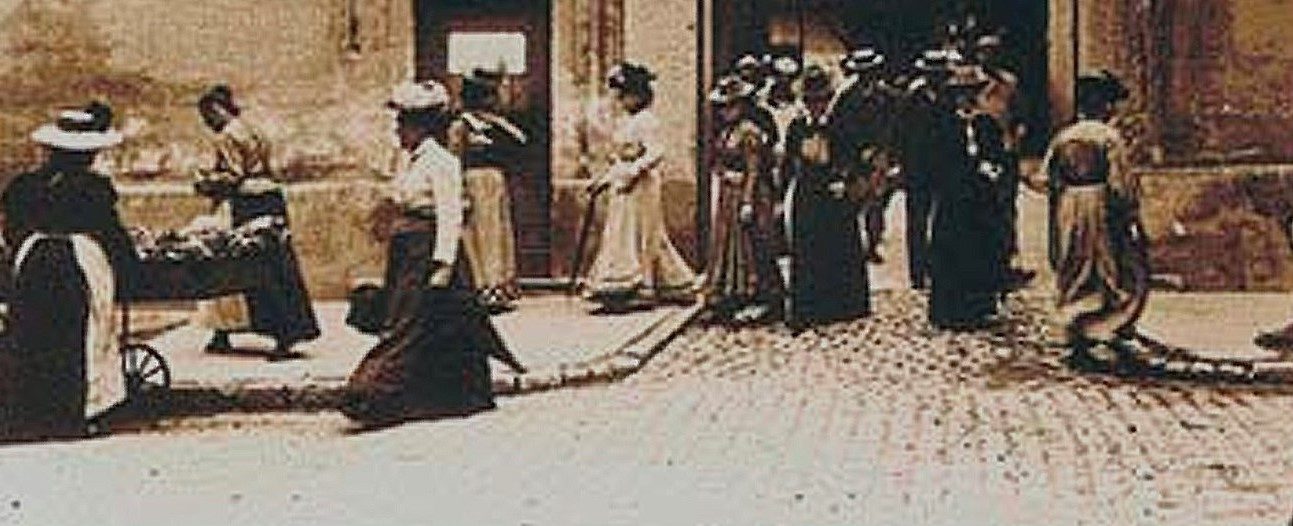Japan, 1971
Directed by Shinoda Masahiro
With David Lampson (Sebastião Rodrigues), Don Kenny (Francisco Garrpe), Tanba Tetsurô (Cristóváo Ferreira), Mako (Kichijiro), Okada Eiji (Inoue Chikugonokami), Toura Rokkô (the interpreter)

Japan comes across first as a wild, verdant, gorgeous landscape, waves pounding against rocky cliffs that are topped by lush grass and rice paddies. Men look tiny as they scramble over the paths leading to the sea or to caves or to villages. They rush to avoid surveillance, to be safe, to believe. For the villagers are Christians and the big white men standing with them are Portuguese Catholic missionaries coming from Macao, the final leg of their tough journey made with the help of a Japanese people smuggler who sympathizes with this faith; but in the Japan of the early 17th century, to worship Christianity is a crime.
The first part of the tragic odyssey of Father Sebastião Rodrigues takes place in the scenic arena provided by the Japanese nature. With his fellow traveler Father Francisco Garrpe, he tries to cater to the spiritual needs of communities still clinging to the imported religion, despite the constant watching and harsh crackdown of the local authorities, under the aegis of Governor Inoue Chikugonokami.
He is brave, determined, fluent in Japanese, some great assets to succeed in this daunting, dangerous task – he is also more optimistic and less grumpy than Father Francisco Garrpe. Unlike him, Sebastião Rodrigues can be more reckless, eager to help and to trust; so, for instance, he still hesitate to dismiss the smuggler who brought them, Kichijiro, as an untrustworthy hick. It seems also that something else drives him, an urge to know the whereabouts of a missionary who has been reported as missing, and who happens to be the man who taught him so much in the seminary, Father Cristóváo Ferreira.
Days go by, bonds are forged, and the depressing rain season gives way to a promising fair weather. But an informer eventually snitches on the illegal presence of the foreigners. The missionaries must run away again, while the village where they found help must face the wrath of the authorities. The Portuguese get separated. The film chooses to focus on the exhausting wandering of Sebastião Rodrigues, who struggles to survive the wilderness and the heat, and must reluctantly rely on the support of the ingratiating but suspicious Kichijiro – who has already been described as too willing to abjure the Christian faith to save his neck. And indeed, he does play the infamous part of Judas, double-crossing his traveling companion.
The long second part of the narrative takes place in an enclosed world most of the time. Buildings, courts, rooms, cells stand as an infinite series of obstacles, walls, bars, lines: Sebastião Rodrigues is taken from one corner to another, doomed to be locked up in stifling spaces. This is the hostile, cold, cruel world of the authorities, of a law set to be enforced whatever the pain and the sorrow of the people. The missionary gets an interpreter who acts essentially as a minder and a manipulator. A former pupil of Christian priests, the interpreter attempts to challenge the rock-solid faith of the prisoner he looks after. Jovial but cynical, the interpreter makes the missionary meet Inoue Chikugonokami, Japanese Christians held prisoners in the same fort, his comrade Franciso Garrpe, who has been also captured, and finally a completely changed Cristóváo Ferreira – who is now officially a Japanese citizen, with a Japanese name, and, it seems, a Japanese state of mind, which appalls his former student.
This is in retrospect a carefully designed plan, a step-by-step scheme to exert not just greater pressure, but more stinging, destabilizing, harrowing pressure, forcing the victim to give up on everything he believes. As Sebastião Rodrigues does not want to stop proselytizing, and still holds Christian tenets as more important than the Japanese values his opponents claim to defend, he is increasingly challenged on the relevance and usefulness of his faith. The goal is to compel him to abjure, as many of his flocks had to survive, with those still objecting to the authorities doomed to death. And the goal would be achieved.
This is a violent story. But, in a remarkable choice, it does not swamped the narrative: violence slowly gathers pace, from a vague but real menace to a terrifying intimate experience. It is played in a crescendo that contributes to undermine the missionary’s resilience and the audience’s hope the worst is not to come. The authorities’ violence is first the poignant memories of an old woman, clearly haunted by the horror she witnessed, over a feast attending by the Portuguese. Then comes the crucifixion and the drowning of a trio Japanese men, but it is viewed by the missionaries, and shot by the camera, at a long, safe distance. Things really take a turn for the worse once Sebastião Rodrigues is captured. The dark and stifling interiors where he is trapped. Like the old woman, he is forced to be the unwilling and appalled witness of torture, in particular the cruel ways used to convince a samurai and his wife to abjure, and later the death of Francisco Garrpe. The meeting with Cristóváo Ferreira is a more intellectual, vicious way to defeat the stubborn captive, dovetailing with the constant teasing and questioning of the interpreter. And then comes the real physical torture, involving blood and a pit – the hole where Sebastião Rodrigues would lose his faith. This step-by-step, increasingly horrible arc is perfectly crafted, reflecting the pervasive and relentless power of the authorities, and the bitter sense that the Portuguese is moving into a spiritual dead end.
This is all the more hopeless as the young man can easily relate his own troubles with the travails of both the Christ and the first Christians (in particular in the Roman Empire), from the ambiguous relationship with a local Judas to the physical sacrifice, from the secret meetings in caves to the zeal to convert and support (like the talk with the samurai’s wife, who has lost her husband and reneged on her beliefs). This experience does bolster Sebastião Rodrigues, up to a point. But it also makes him unable to understand the point made by Inoue Chikugonokami: to him, and others, the universal message of the Christianity hides the influence of a distant Western world that seems keen to intrude on the Japanese life and economy. Using what can honestly be defined as parables, the governor points to the impossibility for his nation to let be absorbed by the interests of foreigners. And anyway, why a faith worshiped in one part of the world should be viewed as fit for the rest of the world?
Soon after being arrested, Sebastião Rodrigues is carried through the countryside to the town of the governor on a donkey. At one point, the Portuguese, who has dressed in a red summer kimono because his old clothes have been torn into rags, is faced with a kind of shaman, who also wears bright red garments and is dancing with a long stick playing in his hands. The man also has a weird head gear and seems in trance, oblivious of the caravan moving behind him. Well after the Portuguese and his wardens have passed, the camera lingers on this riveting ritual performed by a magical person. One believer is led to his defeat; the other basks in the glory of his faith, and of the sun bathing the scenic land he belongs to. This is the story of the failure of adaptation, the heartbreaking attempt of a young man to live through beliefs in a country that proves to big a challenge. He was looking for a harmony that could not have been possible given cultural, economic and political conflict – the Japanese authorities do have a point: missionaries were too often the supporters of a colonizing process wrecking havoc in other, old cultures.
The sophisticated score by great composer Takemitsu Tôru captures the disharmony that comes to define the narrative arc of Sebastião Rodrigues, recreating a typical European Renaissance tune for strings that is slowly interrupted by cringing modernist notes played with Japanese instruments, a well-known melodic flow that struggles to dominate a jarring, eerie counterpoint. Another element of the soundtrack proves essential: it is silence, as emotion overrides the protagonist, especially at the end, over the final gesture he needs to make to put an end to suffering – his own, and other prisoners’ too. It is in silence that he makes it: God, this time, did not speak, leaving the believer deeply alone, and sad. He has eventually lost everything, and it could be that it does not matter to God. The final image shows his face distorted as he makes love to a woman – orgasm in fact looks like rage, as he struggles to become as an ordinary Japanese as Cristóváo Ferreira claims to be. This is a much disquieting, troubling, saddening coda for a film.
This is a remarkably designed and narrated adaptation of an important novel by Endô Shûsaku, who wrote in part the screenplay. The story is fascinating, for both what it tells about the strength of faith, and the passion one can put into a spiritual vision of the man and the world, and for the way it analyses cultural differences and their discontents. It was wonderfully inspirational for director Shinoda Masahiro – and as it happens, it would be so again some three decades later, for another director of a completely different outlook, Martin Scorsese.

